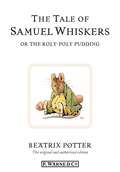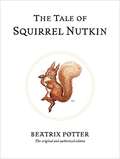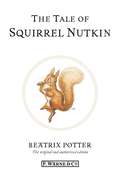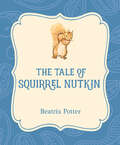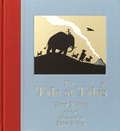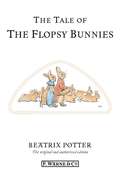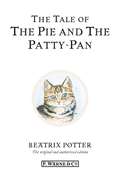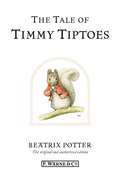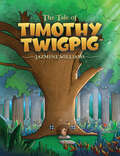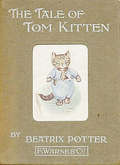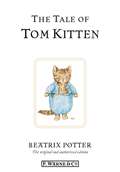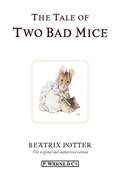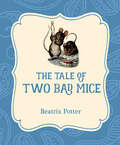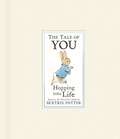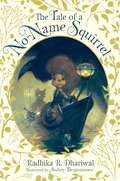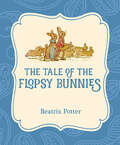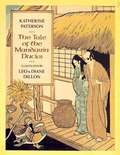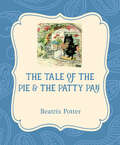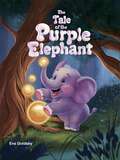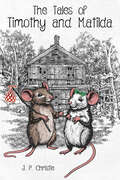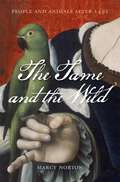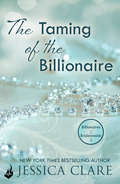- Table View
- List View
The Tale of Samuel Whiskers or the Roly-Poly Pudding (Beatrix Potter Originals)
by Beatrix PotterThis original, authorised version has been lovingly recreated electronically for the first time, with reproductions of Potter's unmistakeable artwork optimised for use on colour devices such as the iPad. The first farm that Beatrix Potter owned, Hill Top, was an old house with thick walls and many hiding places for rats and mice. In The Tale of Samuel Whiskers this farmhouse is Tom Kitten's home and the story tells what happens when Tom accidently comes upon the rat Samuel Whiskers living in a secret hideout behind the attic walls.The Tale of Samuel Whiskers is number 16 in Beatrix Potter's series of 23 little books, the titles of which are as follows:1 The Tale of Peter Rabbit2 The Tale of Squirrel Nutkin3 The Tailor of Gloucester4 The Tale of Benjamin Bunny5 The Tale of Two Bad Mice6 The Tale of Mrs. Tiggy-Winkle7 The Tale of Mr. Jeremy Fisher8 The Tale of Tom Kitten9 The Tale of Jemima Puddle-Duck10 The Tale of the Flopsy Bunnies11 The Tale of Mrs. Tittlemouse12 The Tale of Timmy Tiptoes13 The Tale of Johnny Town-Mouse 14 The Tale of Mr. Tod15 The Tale of Pigling Bland16 The Tale of Samuel Whiskers17 The Tale of The Pie and the Patty-Pan18 The Tale of Ginger and Pickles19 The Tale of Little Pig Robinson20 The Story of a Fierce Bad Rabbit21 The Story of Miss Moppet22 Appley Dapply's Nursery Rhymes23 Cecily Parsley's Nursery Rhymes
The Tale of Squirrel Nutkin
by Beatrix PotterNutkin has no manners, and his rudeness gets him into a lot of trouble! This file should make an excellent embossed braille copy.
The Tale of Squirrel Nutkin (Beatrix Potter Originals)
by Beatrix PotterThis original, authorised version has been lovingly recreated electronically for the first time, with reproductions of Potter's unmistakeable artwork optimised for use on colour devices such as the iPad. Beatrix Potter's famous tale of a naughty squirrel who loses his tail is as popular today as it was when it was first published over 100 years ago. Join Nutkin, his brother Twinkleberry and all his cousins as they make their way over to Owl Island to gather nuts. See what happens when Old Brown, the terrifying owl guardian of the island decides he has had enough of silly Nutkin's cheekiness! Ouch!! The Tale of Squirrel Nutkin is number two in Beatrix Potter's series of 23 little books, the titles of which are as follows: 1 The Tale of Peter Rabbit 2 The Tale of Squirrel Nutkin 3 The Tailor of Gloucester 4 The Tale of Benjamin Bunny 5 The Tale of Two Bad Mice 6 The Tale of Mrs. Tiggy-Winkle 7 The Tale of Mr. Jeremy Fisher 8 The Tale of Tom Kitten 9 The Tale of Jemima Puddle-Duck 10 The Tale of the Flopsy Bunnies 11 The Tale of Mrs. Tittlemouse 12 The Tale of Timmy Tiptoes 13 The Tale of Johnny Town-Mouse 14 The Tale of Mr. Tod 15 The Tale of Pigling Bland 16 The Tale of Samuel Whiskers 17 The Tale of The Pie and the Patty-Pan 18 The Tale of Ginger and Pickles 19 The Tale of Little Pig Robinson 20 The Story of a Fierce Bad Rabbit 21 The Story of Miss Moppet 22 Appley Dapply's Nursery Rhymes 23 Cecily Parsley's Nursery Rhymes
The Tale of Squirrel Nutkin (Xist Illustrated Children's Classics)
by Beatrix PotterA children’s classic offering a lesson in manners from the beloved author of The Tale of Peter Rabbit.In a wood at the edge of the lake lives a squirrel named Nutkin and his brother Twinkleberry. Nutkin is rude little squirrel who tests his luck with Old Brown, a mean old owl, who might just teach this squirrel a lesson in manners . . .
The Tale of Tales
by Tony MittonA new offering by award-winning poet Tony Mitton, beautifully illustrated by Peter Bailey. Short installments comprise The Tale of Tales, the story of a group of animals making their way to Volcano Valley to hear the Tale of Tales, the greatest story ever told. Along the way, the animals meet new travelers and each shares his own story with the group. This delightful story, filled with humor and warmth, and charmingly illustrated throughout with line drawings, is sure to become a favorite for reading aloud, as well as for newly independent readers.
The Tale of The Flopsy Bunnies (Beatrix Potter Originals)
by Beatrix PotterThis original, authorised version has been lovingly recreated electronically for the first time, with reproductions of Potter's unmistakeable artwork optimised for use on colour devices such as the iPad. When the cupboard is bare at the Flopsy Bunny's burrow, the family all have to go in search of food. They soon find some old lettuces on Mr McGregor's rubbish heap, but who can imagine the horrors that await them as they enjoy a nap after lunch!Peter Rabbit and Benjamin Bunny are two of Beatrix Potter's most popular characters and they are brought together in this exciting tale of danger and friendship.The Tale of The Flopsy Bunnies is number ten in Beatrix Potter's series of 23 little books, the titles of which are as follows:1 The Tale of Peter Rabbit2 The Tale of Squirrel Nutkin3 The Tailor of Gloucester4 The Tale of Benjamin Bunny5 The Tale of Two Bad Mice6 The Tale of Mrs. Tiggy-Winkle7 The Tale of Mr. Jeremy Fisher8 The Tale of Tom Kitten9 The Tale of Jemima Puddle-Duck10 The Tale of the Flopsy Bunnies11 The Tale of Mrs. Tittlemouse12 The Tale of Timmy Tiptoes13 The Tale of Johnny Town-Mouse 14 The Tale of Mr. Tod15 The Tale of Pigling Bland16 The Tale of Samuel Whiskers17 The Tale of The Pie and the Patty-Pan18 The Tale of Ginger and Pickles19 The Tale of Little Pig Robinson20 The Story of a Fierce Bad Rabbit21 The Story of Miss Moppet22 Appley Dapply's Nursery Rhymes23 Cecily Parsley's Nursery Rhymes
The Tale of The Pie and The Patty-Pan (Beatrix Potter Originals)
by Beatrix PotterThis original, authorised version has been lovingly recreated electronically for the first time, with reproductions of Potter's unmistakeable artwork optimised for use on colour devices such as the iPad. The Tale of the Pie and the Patty Pan features the houses, gardens and streets of the village of Sawrey, where Beatrix Potter lived, at Hill Top, her first farm. The inhabitants, however, are animals rather than people, and problems arise when Ribby the cat invites Duchess the dog to tea.The Tale of The Pie and the Patty-Pan is number 17 in Beatrix Potter's series of 23 little books, the titles of which are as follows:1 The Tale of Peter Rabbit2 The Tale of Squirrel Nutkin3 The Tailor of Gloucester4 The Tale of Benjamin Bunny5 The Tale of Two Bad Mice6 The Tale of Mrs. Tiggy-Winkle7 The Tale of Mr. Jeremy Fisher8 The Tale of Tom Kitten9 The Tale of Jemima Puddle-Duck10 The Tale of the Flopsy Bunnies11 The Tale of Mrs. Tittlemouse12 The Tale of Timmy Tiptoes13 The Tale of Johnny Town-Mouse 14 The Tale of Mr. Tod15 The Tale of Pigling Bland16 The Tale of Samuel Whiskers17 The Tale of The Pie and the Patty-Pan18 The Tale of Ginger and Pickles19 The Tale of Little Pig Robinson20 The Story of a Fierce Bad Rabbit21 The Story of Miss Moppet22 Appley Dapply's Nursery Rhymes23 Cecily Parsley's Nursery Rhymes
The Tale of Timmy Tiptoes (Beatrix Potter Originals)
by Beatrix PotterThis original, authorised version has been lovingly recreated electronically for the first time, with reproductions of Potter's unmistakeable artwork optimised for use on colour devices such as the iPad. After a terrible misunderstanding, poor Timmy Tiptoes ends up deep inside the trunk of a dead tree, with no means of getting out. Luckily, the chipmunk who lived there was very friendly and kind to Timmy. Before long, a strong wind blows the top off the dead tree trunk, but poor Timmy can't get himself out on account of eating far too many nuts and being a little bit too round!Beatrix wrote this story to appeal directly to her American fans and featured animals of American origin (grey squirrels, chipmunks and a black bear) all living happily in the Lake District woods!The Tale of Timmy Tiptoes is number twelve in Beatrix Potter's series of 23 little books, the titles of which are as follows:1 The Tale of Peter Rabbit2 The Tale of Squirrel Nutkin3 The Tailor of Gloucester4 The Tale of Benjamin Bunny5 The Tale of Two Bad Mice6 The Tale of Mrs. Tiggy-Winkle7 The Tale of Mr. Jeremy Fisher8 The Tale of Tom Kitten9 The Tale of Jemima Puddle-Duck10 The Tale of the Flopsy Bunnies11 The Tale of Mrs. Tittlemouse12 The Tale of Timmy Tiptoes13 The Tale of Johnny Town-Mouse 14 The Tale of Mr. Tod15 The Tale of Pigling Bland16 The Tale of Samuel Whiskers17 The Tale of The Pie and the Patty-Pan18 The Tale of Ginger and Pickles19 The Tale of Little Pig Robinson20 The Story of a Fierce Bad Rabbit21 The Story of Miss Moppet22 Appley Dapply's Nursery Rhymes23 Cecily Parsley's Nursery Rhymes
The Tale of Timothy Twigpig
by Jazmine WilliamsTimothy Twigpig has never been outside. It is, after all, important for a hedgehog to hide. But when he sneaks out, what will Timothy discover? A tale of the humble hedgehog, discovering the world beyond the wood. A book to educate and inspire the next generation to care for our countryside and the wildlife within it.
The Tale of Tom Kitten
by Beatrix PotterTom and his sisters are having a great time in their best clothes until Mother calls them home for a tea party.
The Tale of Tom Kitten (Beatrix Potter Originals)
by Beatrix PotterThis original, authorised version has been lovingly recreated electronically for the first time, with reproductions of Potter's unmistakeable artwork optimised for use on colour devices such as the iPad. The Tale of Tom Kitten is set in the cottage garden Beatrix created herself at Hill Top, the farm she owned near the village of Sawrey. Tom and his sisters look so smart in their new clothes. When their mother sends them outside while she waits for her visitors, she couldn't possibly guess what kind of mess they are going to get themselves into!The Tale of Tom Kitten is number eight in Beatrix Potter's series of 23 little books, the titles of which are as follows:1 The Tale of Peter Rabbit2 The Tale of Squirrel Nutkin3 The Tailor of Gloucester4 The Tale of Benjamin Bunny5 The Tale of Two Bad Mice6 The Tale of Mrs. Tiggy-Winkle7 The Tale of Mr. Jeremy Fisher8 The Tale of Tom Kitten9 The Tale of Jemima Puddle-Duck10 The Tale of the Flopsy Bunnies11 The Tale of Mrs. Tittlemouse12 The Tale of Timmy Tiptoes13 The Tale of Johnny Town-Mouse 14 The Tale of Mr. Tod15 The Tale of Pigling Bland16 The Tale of Samuel Whiskers17 The Tale of The Pie and the Patty-Pan18 The Tale of Ginger and Pickles19 The Tale of Little Pig Robinson20 The Story of a Fierce Bad Rabbit21 The Story of Miss Moppet22 Appley Dapply's Nursery Rhymes23 Cecily Parsley's Nursery Rhymes
The Tale of Two Bad Mice (Beatrix Potter Originals)
by Beatrix PotterThis original, authorised version has been lovingly recreated electronically for the first time, with reproductions of Potter's unmistakeable artwork optimised for use on colour devices such as the iPad. When two naughty little mice discover the door to the beautiful dolls' house ajar, they just have to tiptoe inside and have a look. The temptation to try the delicious looking food in the dining room proves too great however, and chaos ensues when they discover that it will not come off the plates!The Tale of Two Bad Mice is number five in Beatrix Potter's series of 23 little books, the titles of which are as follows: 1 The Tale of Peter Rabbit 2 The Tale of Squirrel Nutkin 3 The Tailor of Gloucester 4 The Tale of Benjamin Bunny 5 The Tale of Two Bad Mice 6 The Tale of Mrs. Tiggy-Winkle 7 The Tale of Mr. Jeremy Fisher 8 The Tale of Tom Kitten 9 The Tale of Jemima Puddle-Duck 10 The Tale of the Flopsy Bunnies 11 The Tale of Mrs. Tittlemouse 12 The Tale of Timmy Tiptoes 13 The Tale of Johnny Town-Mouse 14 The Tale of Mr. Tod 15 The Tale of Pigling Bland 16 The Tale of Samuel Whiskers 17 The Tale of The Pie and the Patty-Pan 18 The Tale of Ginger and Pickles 19 The Tale of Little Pig Robinson 20 The Story of a Fierce Bad Rabbit 21 The Story of Miss Moppet 22 Appley Dapply's Nursery Rhymes 23 Cecily Parsley's Nursery Rhymes
The Tale of Two Bad Mice (Xist Illustrated Children's Classics)
by Beatrix PotterWhen Tom Thumb and Hunca Munca sneak into an empty dollhouse, chaos ensues in this delightful story from the beloved author of The Tale of Peter Rabbit. The Tale of Two Bad Mice is a sophisticated story for children about two little troublemakers who wind up paying for their crimes. Written by Beatrix Potter, it is part of the Xist Publishing Children&’s Classics collection. Each ebook has been specially formatted with full-screen, full-color illustrations and the original, charming text.
The Tale of You: Hopping into Life (Peter Rabbit)
by Beatrix PotterThis inspirational guide to life featuring Peter Rabbit, in the same vein as the Dr. Seuss classic Oh, the Places You'll Go!, is the perfect graduation gift!As Peter Rabbit bounces out into the big, wide world he will face triumphs and setbacks, hopes and fears. He will meet true friends and fearsome foes, but will always have a home to return to, and a family waiting to hear stories of his adventures.Featuring a brilliantly rhythmical rhyming text with characterful new illustrations, this new book is set to become a beloved classic!
The Tale of a Donkey
by Valenti AngeloA donkey is bought at auction by a stonecutter, a woodcutter and a farmer who share him and mistreat him. He escapes, becomes ill from eating poisoned flowers, and is found by a boy who, with his family, nurse him back to health and treat him well. The owners come for him but a judge decides in court to whom the donkey belongs. Includes picture descriptions. This file should make an excellent embossed braille copy.
The Tale of a No-Name Squirrel
by Radhika R. Dhariwal Audrey BenjaminsenSolve riddles with Squirrel as he travels to the walled city of bees, the fireless tea plantation of mice, and treacherous desert full of tricksters in this beautifully written and creative debut adventure.Squirrel never expected to be anything other than a slave: the last animal slave in Bimmau. That is, until he is invited to a high profile wedding and takes a sip of the forbidden ceremonial wine, unlocking a mysterious riddle. The riddle reveals that there is a key which has the power to grant Squirrel his freedom (and a name!), but also could enslave anyone in Bimmau. Disastrous if it falls into the wrong hands! Squirrel and his friends find themselves in a race to find Brittle's Key before the army of crows gets to him...and before the mysterious Colonel finds the key first.
The Tale of the Flopsy Bunnies: Large Print (Xist Illustrated Children's Classics)
by Beatrix PotterBenjamin Bunny&’s offspring learn the perils of gluttony in this charming story from the popular author of The Tale of Peter Rabbit. In this story, Benjamin Bunny&’s children, the Flopsy Bunnies, eat so much lettuce from Mr. McGregor&’s garden that they become sleepy and are almost turned into a rabbit pie. The Tale of the Flopsy Bunnies by Beatrix Potter is part of the Xist Publishing Children&’s Classics collection. Each ebook has been specially formatted with full-screen, full-color illustrations and the original, charming text.
The Tale of the Mandarin Duck: A Modern Fable
by Bette MidlerNEW YORK TIMES BESTSELLER • Inspired by the real-life rainbow-colored Mandarin Duck who appeared in New York&’s Central Park in 2018, this modern fable by Bette Midler celebrates the connections people make with each other and the world around them. How do you get people to appreciate what is right in front of them? In The Tale of the Mandarin Duck, it takes a mysterious, beautiful duck and a clear-eyed kid to point out the obvious! Bette Midler&’s distinctive voice joins striking photos of the real duck by Michiko Kakutani and charming black-and-white drawings by Joana Avillez. This book will have readers of all ages coming back to visit the fantastical interpretation of New York City and its odd ducks—both feathered and human. An afterword by Ms. Kakutani adds details to the facts behind this one-of-a-kind story of the Mandarin Duck.
The Tale of the Mandarin Ducks
by Katherine PatersonA pair of mandarin ducks, separated by a cruel lord who wishes to possess the drake for his colorful beauty, reward a compassionate couple who risk their lives to reunite the ducks. <P><P>[This text is listed as an example that meets Common Core Standards in English language arts in grades 6-8 at http://www.corestandards.org.]
The Tale of the Pie & the Patty Pan: Large Print (Xist Illustrated Children's Classics)
by Beatrix PotterTummy troubles prompt a dog to commit the ultimate pie switcheroo in this funny story from the renowned author of The Tale of Peter Rabbit. The Tale of the Pie & the Patty Pan tells the story of two friends who like different foods but don&’t want to hurt each other&’s feelings. Written by Beatrix Potter, it is part of the Xist Publishing Children&’s Classics collection. Each ebook has been specially formatted with full-screen, full-color illustrations and the original, charming text.
The Tale of the Purple Elephant
by Eva GoldsbyThe story of the Purple Elephant who found the beauty of his true self
The Tales of Olga da Polga (Olga da Polga #1)
by Michael Bond"From the very beginning, there was not the slightest doubt that Olga da Polga was the sort of guinea pig who would go places." And just as soon as she had picked an appropriately exotic name for herself, Olga did go, abandoning the pet shop for excitement with the Sawdust People (guinea pigs' name for humans). Olga is delighted with the move as she discovers new situations and friends that encourage and illuminate her remarkable talents. Olga's imaginative tall tales finally find an appreciative audience in Noel the cat; her spirit of adventure is unleashed by Fangio the hedgehog and the dreadful Surrey Puma; and her vanity and self-indulgence are satisfied by a contest, a traumatic accident, and a generous midnight visitor. Michael Bond, creator of the beloved Paddington Bear, has written an enchanting and very funny book about the incredible adventures of a vain, inventive and altogether fetching guinea pig.
The Tales of Timothy and Matilda
by J. P. ChristieEmbark on an enchanted journey with cousins Timothy and Matilda, two adventurous mice. They dare to dream beyond the safety of their cosy home, an old wooden house in the heart of the woods, where they have grown up with their vast extended family. Inspired by the tales of their uncle, the daring pair set out on a trip that will redefine the boundaries of their world. As they travel, they encounter an array of creatures, some destined to become lifelong friends, others posing more dangerous challenges. With boundless bravery and unwavering resilience, Timothy and Matilda navigate their way through the forest, determined to reach the bustling port of Southampton, hoping to find a boat to sail the seas. Will they conquer the dangers of the forest, or will unforeseen obstacles threaten to shatter their dreams? Join Timothy and Matilda on a marvellous adventure that celebrates courage, resilience, friendship, and the possibilities that occur when daring to explore beyond the familiar.
The Tame and the Wild: People and Animals after 1492
by Marcy NortonA dramatic new interpretation of the encounter between Europe and the Americas that reveals the crucial role of animals in the shaping of the modern world.When the men and women of the island of Guanahani first made contact with Christopher Columbus and his crew on October 12, 1492, the cultural differences between the two groups were vaster than the oceans that had separated them. There is perhaps no better demonstration than the divide in their respective ways of relating to animals. In The Tame and the Wild, Marcy Norton tells a new history of the colonization of the Americas, one that places wildlife and livestock at the center of the story. She reveals that the encounters between European and Native American beliefs about animal life transformed societies on both sides of the Atlantic.Europeans’ strategies and motives for conquest were inseparable from the horses that carried them in military campaigns and the dogs they deployed to terrorize Native peoples. Even more crucial were the sheep, cattle, pigs, and chickens whose flesh became food and whose skins became valuable commodities. Yet as central as the domestication of animals was to European plans in the Americas, Native peoples’ own practices around animals proved just as crucial in shaping the world after 1492. Cultures throughout the Caribbean, Amazonia, and Mexico were deeply invested in familiarization: the practice of capturing wild animals—not only parrots and monkeys but even tapir, deer, and manatee—and turning some of them into “companion species.” These taming practices not only influenced the way Indigenous people responded to human and nonhuman intruders but also transformed European culture itself, paving the way for both zoological science and the modern pet.
The Taming Of The Billionaire: Billionaires And Bridesmaids 2 (Billionaires and Bridesmaids #2)
by Jessica ClareWelcome to the illustrious world of Jessica Clare's billionaires and bridesmaids. Fans of J.S. Scott, Louise Bay and Melody Anne will be utterly seduced by this New York Times bestseller. You met the six bachelors of the Billionaire Boys Club... Now it's time to pair up some filthy-rich billionaires with lucky ladies in waiting and enjoy the spoils... When overbearing cat behaviorist Edie meets newly-rich game developer Magnus, the feeling of loathing is entirely mutual. Thrown together for their friends Gretchen and Hunter's wedding, unfortunately there's no escaping one another. At first Magnus isn't interested in the slightest, but Edie is...intriguing. And stubborn. And smart. And sexy. They might even have more in common than they thought. And before long, it becomes a challenge between the two of them to see who will be tamed first...Want more enthralling, extravagant romance? Look out for the rest of the Billionaire and Bridesmaids series starting with The Billionaire And The Virgin or take a spin with the steamy Billionaire Boys Club starting with Stranded With A Billionaire.
